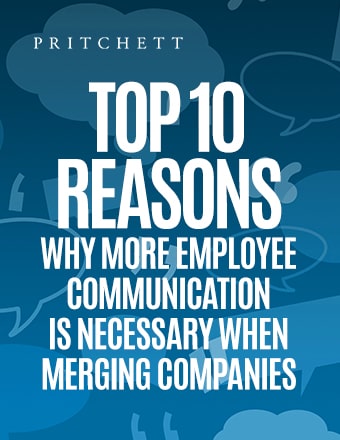Answers to Post-Merger FAQS on:
Best Practices
Day 1
M&A Integration Teams
M&A Integration Plans
Acquisition Integration
Culture
Risks
Managing People
Post-Merger Exam
Based on Answers to FAQs
In early M&A communications, what are common mistakes? And what can executives say that will not harm their credibility?
Mistake #1: Acting Like You Have All the Answers (or Will Have Them Very Soon)
- Things change too fast to make many promises early in an integration
- Better to position communications as “what we know now”
- The one thing you can promise is “change”
- Sometimes better to listen than struggle to provide answers
Safe to say:
“We will need some time to answer that question. There are alternatives and they each have their own set of challenges.”
“Unfortunately, early in M&A integrations, there are always many more questions than answers. What I can say is that as we make decisions, we will communicate them to you quickly.”
Mistake # 2: Sugar Coating the Truth
- The first instinct is to try to soothe the masses
- Better to be honest and share a balanced view
- Sell the upside of the deal but acknowledge integrations are not easy
Safe to say:
“There are always problems when merging organizations. Problems are growing pains. They are natural side effects of integrations."
If there is the possibility of job loss but no decision has been made:
“I can’t tell you whether jobs will be eliminated. Instead, I will share with you what we know now…”
Mistake 3: Forgetting the “Me” Issues
- Always remember, the first two letters in Merger is “Me”
- Communicate from the individual’s point of view
- Don't talk to non-shareholder employees as if they were shareholders (e.g., “This is a great deal because of cost synergies” is not motivating for employees)
Safe to say:
If true:
At the current time we plan no changes to your health coverage, vacation time, or commissions through (a certain date).”
Mistake 4: Acting Superior
- Emphasize the positives about the acquiree not just the acquirer
Safe to say:
“A major reason we are doing this deal is because of the acquiree's strengths.”
“We will be leveraging the capabilities of the acquiree.”
How do you build credibility with the acquired company’s employees?
Don’t blow smoke. Don’t shave the truth. Don’t play the propaganda game. You can’t con these people, at least not for long. Besides, you’re dealing with adults here, and they deserve the truth. Build your credibility by leveling with them. Give it to them straight—the good, the bad and the ugly. Arm them with understanding—feed them a steady flow of accurate information—if you want to enlist their support for the merger.
What are the best practices for internal post-merger integration communications?
- Don’t promise that things will remain the same. Most people won’t believe you anyway, and most of those who do will later insist that you have lied or misrepresented things to them. Explain that there will be changes, but that extreme effort will be made to (a) consider the interests of each employee and (b) keep them as well informed as possible of forthcoming changes.
- Make few promises. Realize that promises of any type, as a general rule, will end up making life harder for you. In fact, even when you communicate something through innuendo, you can create expectations that will later prove to be a problem. Your hints will often be taken as hard data.
- Talk in specifics whenever you can. Try not to add to the ambiguity. Be structured in your approach. What seems obvious to you is often unfamiliar and complex to others. Explain things in clear, straightforward language—avoid in-house jargon—and don’t be too sketchy or talk in too general terms. Always check for understanding.
- Be acutely aware of the impact of your comments, even in routine conversation. People will be trying to read things into almost everything you say. You are under a microscope now. A casual remark or careless wording can crank up rumors when you should be doing everything you can to short-circuit speculation, conjecture, and misinformation.
- Provide more communication than usual during and after the merger/acquisition. Strive to overcome the information vacuum that typically develops. Maintain closer-than-usual contact because everyone becomes increasingly hungry for information.
- Listen with the third ear. Pay attention to how something is said, as well as to the actual verbal content of the message. The way someone in the acquired firm communicates may provide you with better information than do the words themselves. Be alert to implied meanings and hidden agendas. Deal with the total message: what’s not said as well as what is, what’s implied as well as what’s said, the nonverbal as well as the verbal.
- Be humble. Go out of your way to avoid behaving in a manner that might be construed as arrogant, superior, critical, abrasive, and the like. People in the acquired firm will be defensive. Don’t threaten or intimidate, even accidentally, as there is enough anxiety out there already. Be respectful.
- Exercise your best public relations skills. Make people in the acquired firm feel important. Help make them feel they are a welcome part of the corporate family, not a stepchild or second-class citizen. Show empathy and patience.
- Provide a clear sense of direction. Be purposeful. Any acquisition is more likely to be responsive to new leadership if there is straight-forward communication regarding what the new leaders want done and how the acquired organization is expected to work toward those goals.
Respect the fact that uncertainty at the top increases the resistance to change at the lower levels. The acquired workforce and management team are far more likely to rally and do battle for a new administration’s goals if that leadership sounds the charge in an unambiguous fashion.
- Don’t just assume the acquired company will follow the parent company’s rules, policies, and procedures without being told what they are. In fact, employees of the acquired company probably will have to be told a number of times before the message takes hold as it should.
- Coach the parent company managers you plan to “send across” into the acquisition regarding how you want them to make their entrance or debut. This deserves a day of careful training involving discussion of the situation, consideration of cultural differences, plus an analysis of personalities and the management style people are accustomed to in the acquired firm.
Why is more communication necessary in M&A?
- More questions than answers
- Rumor mill cranks at E-speed
- The truth is a moving target
- New and different information routes
- Confusion over whom to include
- Skepticism and lack of trust
- Desire for more information and better answers
- Less willing to commit to decisions
- More is happening
- Messages get “slicked up”




